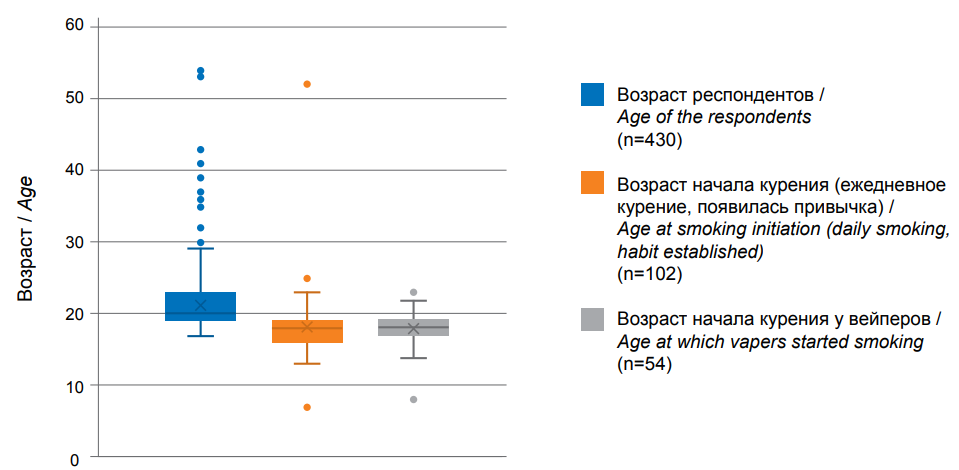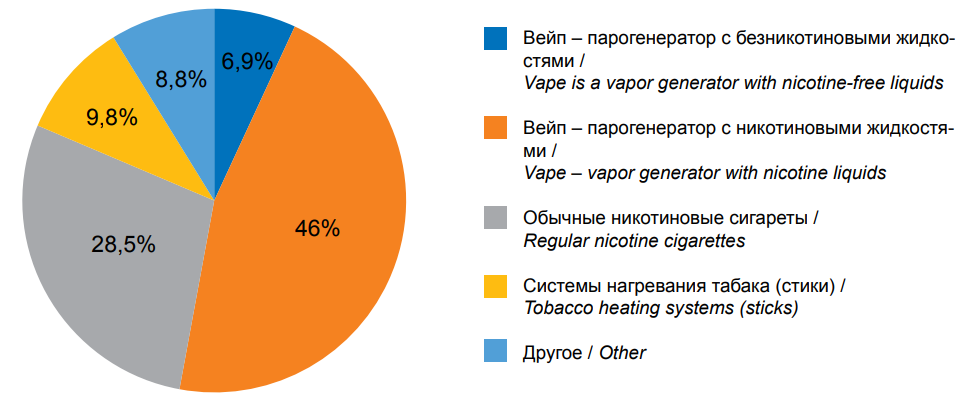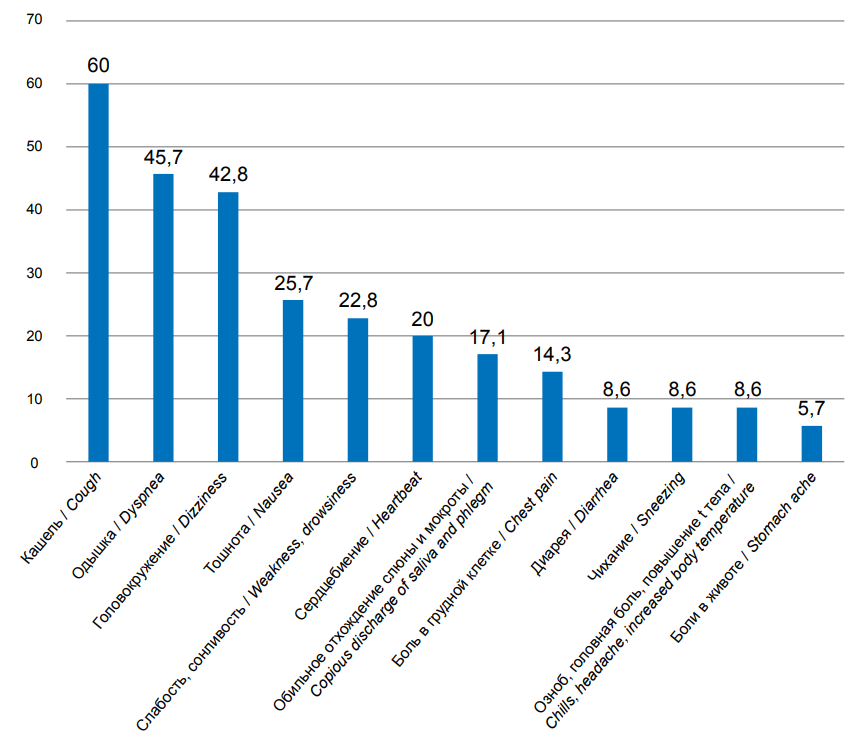Scroll to:
The problem of vaping among the young population
https://doi.org/10.21886/2219-8075-2024-15-3-42-47
Abstract
Objective: to study the prevalence of vaping and its negative impact on the health of young people.
Materials and methods: a sociological study was conducted using a voluntary anonymous survey of 430 1st–6th year students of the Federal State Budgetary Educational Institution of Higher Education “Kaluga State University n. a. K.E. Tsiolkovsky” aged 17 to 54 years.
Results: there were 102 smoking respondents (23.7%) and 328 (76.3%) non-smokers. The average age of smoking initiation was 18.2±0.4 years. The distribution by type of smoking was as follows: vaping with nicotine liquids 46%, regular nicotine cigarettes 28.5%, heated tobacco systems (sticks) 9.8%, vaping with nicotine-free liquids 6.9% and other types of smoking 8.8%. The majority of vapers surveyed, 64.8% (35 people), develop complaints (signs of lung injury associated with vaping) during or after vaping. It was found that significantly more often women noted signs of injury associated with vaping (77.2% versus 22.8% in men, p=0.0036).
Conclusions: the results of the study showed that vaping is the most popular form of smoking among young people, which poses a serious threat to the health of young people.
For citations:
Lapshina I.S., Tsybikova E.B., Elistratov E.A. The problem of vaping among the young population. Medical Herald of the South of Russia. 2024;15(3):42-47. (In Russ.) https://doi.org/10.21886/2219-8075-2024-15-3-42-47
Introduction
In the last few years, so-called electronic cigarettes, or vapes, have been gaining popularity among young people in our country [1]. The process of smoking them has acquired the name of vaping, and the smokers themselves are called vapers [1][2].
Vape liquids include propylene glycol, glycerin, various flavourings, colourings, and nicotine [3]. In addition, aerosols often contain salts of heavy metals, volatile organic compounds, acetone and formaldehyde, and their concentration is usually higher compared to traditional cigarettes. According to some authors, vape liquids often contain tetrahydrocannabinol, a psychoactive component of cannabis [2–5].
A serious problem at present is the lack of state standards and no certification of the vape liquids composition [6]. Such liquids are often produced by a non-industrial method, and the composition marked on the packaging is inaccurate.
In addition, there exists a huge number of pseudo-scientific articles that present vaping not only as an absolutely safe activity but also as a way to quit smoking [1]. However, it should be remembered that propylene glycol, when heated, turns into propylene oxide which is a carcinogen and can lead to asthma or pneumonia. Some aerosols contain acrolein – an unsaturated aldehyde formed from glycerol. It is toxic to the human body and can cause chronic lung diseases. The included flavourings contain diacetyl and acetylpropionyl – toxic chemical compounds used in sweet and oily flavours such as vanilla and cinnamon [6].
Currently, there are very few studies in scientific literature devoted to the impact of vapour inhalation on human health. However, already now, many authors mention a new disease – EVALI – that has become known with the appearance of vapes, which translates as “electronic-cigarette or vaping product use-associated lung injury” [1][3][7].
All this makes it relevant to explore the vaping spread issue and its impact on the health of young people.
The aim of the study is to investigate the prevalence of vaping and its negative impact on the health of young people.
Materials and methods
A sociological study was carried out by voluntary anonymous questioning involving 430 students in the 1st-6th years of study at the Federal State Budgetary Educational Institution of Higher Education “Kaluga State University named after K.E. Tsiolkovsky” aged 17 to 24.
The sample coverage of respondents was set using Epi-info, a computer programme developed for population-wide epidemiological testing (Population Survey, CDC Atlanta, USA). The data were collected using a standardised questionnaire containing both close-end (with pre-formulated answers) and free-answer questions.
The questioning results were evaluated using standard statistical processing methods involving Student’s t-criterion and Pearson’s chi-square criterion. The statistical analysis was performed using the StatTech v.4.0.4 software (developer StatTech LLC, Russia). Differences were considered reliable at p<0.05.
Results
In the course of the survey, a total of 430 students in the 1st-6th years of study at Kaluga State University named after K.E. Tsiolkovsky were questioned. They included 116 (26.9%) men and 314 (73.1%) women (Table 1). The respondents’ average age was 21.3±0.2 years (Fig. 1).

Рисунок 1. Сравнение возраста респондентов, возраста начала курения среди курящих респондентов и возраста начала курения у вейперов.
Figure 1. Comparison of age of respondents, age of start of smoking among smoking respondents and age of start of smoking among vapers.
The survey encompassed 102 (23.7%) smoking respondents and 328 (76.3%) non-smoking respondents (Table 1). The mean age of smoking initiation (daily smoking, new habit) among the smoking respondents was 18.2±0.4 years (Fig. 1). When comparing the respondents by gender, it was found that male smokers were significantly predominant (42% vs. 22.2%), with the prevalence of female smokers in the non-smoking group (77.8% vs. 58%) (p=0.0001).
Таблица / Table 1
Результаты анкетирования в сравнении среди мужчин и женщин
Survey results for men and women
|
Всего респондентов Total respondents, n=430 |
Мужчины Men, n=116 (26,9%) |
Женщины Women, n=314 (73,1%) |
p |
|
Курит Smokes, n=102 (23,7%) |
43 (42%) |
59 (58%) |
0,0001 |
|
Не курит Not smoke, n=328 (76,3%) |
73 (22,2%) |
255 (77,8%) |
|
|
Курит вейп (вейпинг) Vaping, n=54 (52,9%) |
20 (37%) |
34 (63%) |
0,1527 |
|
Другие виды курения Other types of smoking, n=48 (47,1%) |
23 (48%) |
25 (52%) |
|
|
Во время или после вейпинга есть жалобы (признаки травмы лёгких, ассоциированной с вейпингом) Have complaints during or after vaping (signs of lung injury associated with vaping), n=35 (64,8%) |
8 (22,8%) |
27 (77,2%) |
0,0036 |
|
Во время и после вейпинга жалоб нет There are no complaints during and after vaping, n=19 (35,2%) |
12 (63,2%) |
7 (36,8%) |
The distribution by smoking type among the 102 smoking respondents was as follows (Figure 2): vaping with nicotine liquids (46%), regular nicotine cigarettes (28.5%). Smoking tobacco heating systems (sticks) (9.8%), vaping with nicotine-free liquids (6.9%) and other types of smoking (8.8%) were almost three times less common.

Рисунок 2. Распределение видов курения среди респондентов.
Figure 2. Distribution of types of smoking among respondents.
When comparing vapers and users of other smoking methods by gender, no significant differences were found (p=0.1527). Thus, although vaping is the most popular way of smoking among young people, men and women equally practise it (Table 1).
The age of smoking initiation among vapers was 18.0±0.3 years. At the same time, the age of smoking initiation among female vapers was slightly lower (17.7±0.4 years) than among males (18.6±0.5 years) (t=1.29, p=0.2036).
When interviewing the vapers, 94.4% (51 persons) of them answered that they considered vaping harmful to health; the remaining 5.6% (3 persons) were not aware of the harm. A total of 85.2% (46 persons) knew about lung injury associated with vaping; 9.3% (5 persons) had heard about the injury but considered this information untrue, and another 5.5% (3 persons) did not know anything about it and had never heard about this pathological condition.
A total of 74% (40 persons) reported smoking vape daily, on a regular basis, while the remaining 26% (14 persons) smoked vape sometimes, occasionally.
The majority of the vapers (63% (34 persons) knew the composition of the vape liquid but did not care to study it in detail when buying. Another 26% (14 persons) knew the composition of the purchased liquid and always familiarised themselves with it when buying. Only 11% (6 persons) did not know the composition of the liquid and had never been interested in this.
The reported choice of vape liquid was influenced by flavouring 88.9% (48 responses), the presence of nicotine in the liquid 37% (20 responses) and price 3.7% (2 responses).
Most of the interviewed vapers (64.8% (35 persons) reported complaints (signs of vaping-associated lung injury) they felt during or after vaping, while the remaining 35.2% (19 persons) did not have any complaints. At the same time, signs of vaping-associated lung injury were much more frequently reported by women (77.2% vs. 22.8% by men, p=0.0036) (Table 1).
Among the vaping-associated lung injury complaints (Fig. 3), the most common were cough (60%), dyspnoea (45.7%) and dizziness (42.8%). Nausea (25.7%), weakness and drowsiness (22.8%), rapid heartbeat (20%), excessive salivation and expectoration (17.1%), and chest pain (14.3%) were somewhat less common. Such complaints as diarrhoea, sneezing, elevated temperature and abdominal pain occurred in isolated cases.

Рисунок 3. Структура жалоб, появляющихся у респондентов во время или после вейпинга, характерных для травмы лёгких, ассоциированной с вейпингом.
Figure 3. Structure of complaints that respondents have during or after vaping, characteristic of lung injury associated with vaping.
Discussion
The survey results showed that one in four students (23.7% of the respondents) were addicted to smoking. The average age of smoking initiation (daily smoking, new habit) was 18.2±0.4 years. This is evidence of the widespread prevalence of smoking among young people. Despite the widespread propaganda of smoking cessation, this problem remains highly relevant [8–10].
Vaping proved to be the most popular form of smoking among young people (53%); the share of vapers among the surveyed students was 12.6%. This is most likely due to the fashion for this type of smoking and the desire of young people to belong to certain socio-cultural groups [11][12], which is confirmed by the number of vapers who knew about the harm of this smoking method (64.4%) and the possibility of developing a vaping-associated lung injury (85.2%).
The survey revealed that almost two-thirds of the vapers had complaints characteristic of vaping-associated lung injury, with a significantly higher prevalence of such complaints among women (77.2% vs. 22.8% in men). Cough (60%), dyspnoea (45.7%) and dizziness (42.8%) were the most common signs of vaping-associated lung injury, as evidenced by the detrimental effect of vaping on the respiratory system and the decreased respiratory function. Such pathological conditions per se blight the vapers’ lives and, with prolonged exposure, lead to decreased airway elasticity and the development of obstructive pulmonary and respiratory diseases [7][13][14].
Conclusions
Thus, the survey results have shown that smoking is so far quite common among young people: one in every four students (23.7%) is addicted to smoking. Vaping is the most popular form of smoking (52.9% among smokers); one in eight students (12.6%) is a vaper. Almost two-thirds of vapers (64.8%) have signs of vaping-associated lung injury, with girls being affected much more frequently. All this suggests that vaping is not a safe alternative to conventional cigarettes and poses a serious threat to the health of young people.
References
1. Mitryaykina K.V., Ivanova E.V.. Vape – a harmless toy or irreparable harm to health? Issues of expertise and quality of medical care. 2023;(3):6–7. (In Russ.) eLIBRARY ID: 53954010.
2. Huang J, Kornfield R, Emery SL. 100 Million Views of Electronic Cigarette YouTube Videos and Counting: Quantification Content Evaluation, and Engagement Levels of Videos. J Med Internet Res. 2016;18(3):e67. https://doi.org/10.2196/jmir.4265
3. Podzolkov V.I., Vetluzhskaya M.V., Abramova A.A., Ishina T.I., Garifullina K.I. Vaping and vape-associated lung damage. Therapeutic archive. 2023;95(7):591–596. (In Russ.) https://doi.org/10.26442/00403660.2023.07.202293
4. Boccio CM, Jackson DB. Adolescent nicotine and marijuana vaping activity and the use of other illicit substances. Drug Alcohol Depend. 2021;219:108469. https://doi.org/10.1016/j.drugalcdep.2020.108469
5. Evtropkova D.S., Polevoy A.O. Is vaping “harmless smoking”? Trends in the development of science and education. 2023;99(6):60–63. (In Russ.) https://doi.org/10.18411/trnio-07-2023-330.
6. Vasil'eva T.E., Gerasimova E.V. How is vaping harmful to human health? Student science and the 21st century. 2021;18(1):14–16. (In Russ.) eLIBRARY ID: 48059737
7. Terletskaya E.Yu., Greben' A.N. Assessment of external respiratory function in students using vaping devices. Collection of materials of the XIII Republican scientific and practical conference with international participation, dedicated to the memory of E.L. Krasavtseva. 2023:88–91. (In Russ.) eLIBRARY ID: 55811899
8. Popova N.M., Galiullin I.R., Timerkaeva A.A. Smoking of electronic cigarettes among students of higher educational institutions. Capital of Science. 2019;12(17):16–21. (In Russ.) eLIBRARY ID: 42779004 EDN: ZTJNDO
9. Pankina I.A., Belokurova E.S. Smoking of electronic cigarettes among university students. Bulletin of the Bashkir State Medical University. 2017;(5):109–112. (In Russ.) eLIBRARY ID: 37037529
10. Veselova EI, Baltachev AA, Tolmachev DA. Study of the prevalence of smoking among 4th year students of the Faculty of Medicine of the Izhevsk State Medical Academy. Modern science. 2020;3(11):249–252. (In Russ.) eLIBRARY ID: 44297537
11. Karaseva V.V., Zholudev S.E., Elovikova T.M. Results of monitoring the opinions of medical university students about various types of smoking. Medical education today. 2021;2(14):28–36. (In Russ.) eLIBRARY ID: 46210700
12. Lashevich S.A., Brizgalova V.S. Prevalence of smoking among medical students and the impact of various methods of nicotine delivery on the body of smokers. Collection of abstracts of the 84th interregional scientific and practical conference with international participation of the student scientific society named after Prof. N.P. Pyatnitsky. Krasnodar; 2023:229-231. (In Russ.) eLIBRARY ID: 54344089
13. Mikhaylovskiy A.I., Voytsekhovskiy V.V., Luchnikova T.A. The effect of e-liquids on the human respiratory system. Clinical observation of a patient with EVALI. Bulletin of Physiology and Pathology of Respiration. 2022;(84):93–99. (In Russ.) https://doi.org/10.36604/1998-5029-2022-84-93-99.
14. Lipilkin P.V., Kulaeva E.D., Zeltser A.N., Mordanov S.V., Shatokhin Yu.V. Myelodysplastic syndrome: epidemiology, diagnostics and epigenetic disorders. Medical Herald of the South of Russia. 2022;13(2):179-190. (In Russ.) https://doi.org/10.21886/2219-8075-2022-13-2-179-190
About the Authors
I. S. LapshinaRussian Federation
Irina S. Lapshina, Cand. Sci. (Med.), Associate Professor, Department of Internal Medicine, Medical Institute;
Leading Researcher, Department of Public Health and Demography
Kaluga;
Moscow
E. B. Tsybikova
Russian Federation
Erzheni B. Tsybikova, Dr. Sci. (Med.), Chief Researcher, Department of Public Health and Demography
Moscow
E. A. Elistratov
Evgeny A. Elistratov, fourth-year student, Chairman of the Council of the Student Scientific Society
Kaluga
Review
For citations:
Lapshina I.S., Tsybikova E.B., Elistratov E.A. The problem of vaping among the young population. Medical Herald of the South of Russia. 2024;15(3):42-47. (In Russ.) https://doi.org/10.21886/2219-8075-2024-15-3-42-47







































